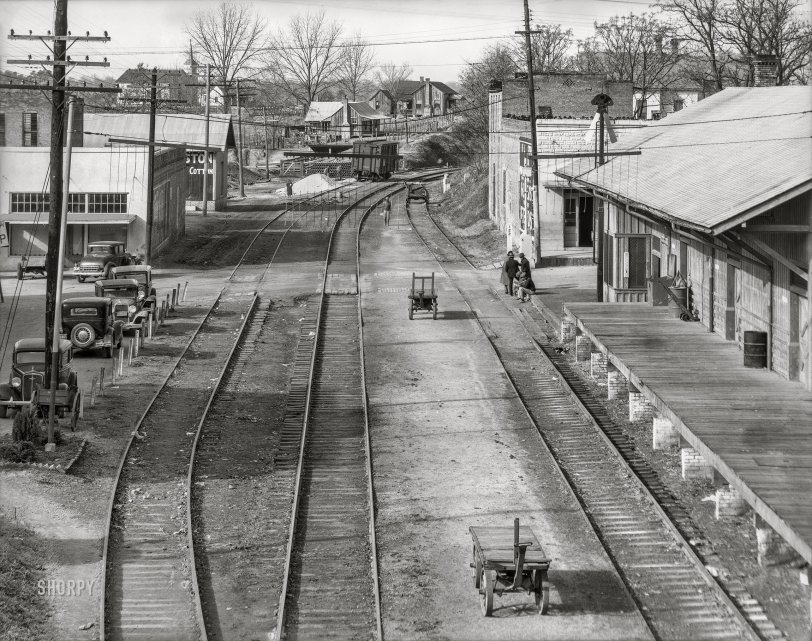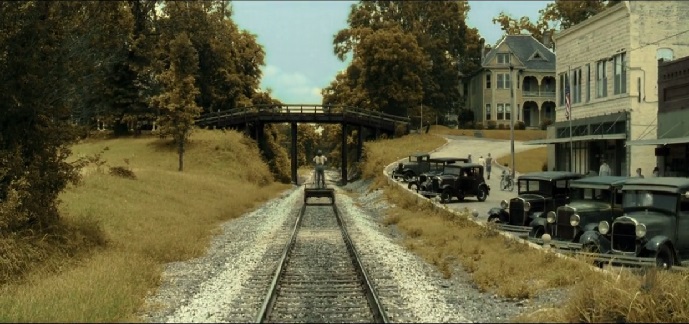


Framed or unframed, desk size to sofa size, printed by us in Arizona and Alabama since 2007. Explore now.
Shorpy is funded by you. Patreon contributors get an ad-free experience.
Learn more.

- Lofty addition
- In 1912
- Keenan Building
- Six years old
- Taken from the P.J. McArdle Roadway?
- It stood only 47 years
- Three track mind
- Incline to the right
- Reach for the sky, 1912 style
- No clean sweep
- Same Job Title, Same Face
- Sadly Lost
- Beautiful ...
- Where you get your kicks
- Aim High
- Pueblo Revival sisters
- Pueblo Neoclassicism
- Milk Man
- Regional dialect.
- Spielberg's inspiration
- Great Photo
- Loaf Story
- Do you still have the Rakes category?
- Could almost be a scene from the 1957 movie 'Hell Drivers'
- The Wages of Fear.
- Conspicuous by their absence
- Got Milk?
- All that aluminum
- No lefties
- Smoke 'em if you've got 'em
Print Emporium
Edwards Depot: 1936

February 1936. "View of railroad station. Edwards, Mississippi." 8x10 inch nitrate negative by Walker Evans for the U.S. Resettlement Administration. View full size.
Phantom Station
In Doug Floor Plan's modern view of the area, it seems that I can see the "ghost" of that long-ago station: lighter patches of grass where buildings used to stand. I guess it's a good example of how quickly human-made constructions can disappear from view and leave no trace, except for some fainter vegetation.
Telltales
These were to warn railroad workers on top of the cars (usually brakemen) that the train was approaching a low overhead structure, in this case the highway overpass from which the photo was taken. As railroad braking systems improved, the need for "decorating" the cars reduced, until the practice is now forbidden.
Order Board
The 2 faced lower quadrant semaphore protruding from the roof of the combined passenger and freight station was not used to control train movements. Instead, it is an "Order Board", controlled by the station agent via vertical rods, used to notify train crews that they needed to pick up train orders, called "flimsies", since they were written on tissue paper to create multiple carbon copies. Depending on the importance of the train order, they could either be picked up on the fly by spearing a thin wooden hoop with your arm, or safety related orders required the crew to stop and sign for the orders. In either case, copies of the orders were delivered to both the engine crew(s) and the conductor in the caboose. The order board indicated which kind of orders they were. A double header with a caboose and pusher would require 4 copies, plus a copy for the agent's records.
Train orders are still used, issued to crews by the dispatcher via radio, with mandatory correct readback from the crew, and the radio traffic recorded in case of an incident. The crew writes the orders on a paper form in the cab.
Those telltales saved lives. In the days before portable "lunchbox" brakeman radios and diesel dynamic brakes, there were several reasons for brakemen to stand on car tops, to signal the engineer while switching around a curve, and to apply and release handbrakes on a downgrade. Incredibly dangerous to keep your balance, and step to the next car, apart from being knocked off the roof by a bridge or tunnel. Eventually, the roof walks were removed, and the ladders leading up to the roof were shortened to just be something to hold on to when riding on the end of a car while switching. Still dangerous work if you aren't alert.
I'm old enough to have seen the tail end of this era, as a kid spent many hours talking with agents in stations and manual "armstrong" interlocking towers, listening to the dispatcher's party line. Knew several crossing watchmen, who spent their days in little towers at major railroad crossings, pumping down the pneumatic crossing gates for each train. I have a small brass 2 lever frame used by the agent to control an order board.
O' Brother, Where Art Thou.
From the crossing looking towards the bridge is from the move O' Brother, Where Art Thou? At the end of the movie this shot is used. Larry is correct, a modeler's dream. On my list to include in my layout.

Zero stoplights, three pages
Is how someone might have described Edwards in 1936; the "pages" of course being the Sanborn fire maps (In short, a pretty small place; but a step up from one page, and obviously two steps up from not being mapped at all).
The map tells us Edwards seems to have been a more interesting place than it is now: for example the brick buildings beyond the station were but two of a long stretch of such structures -- "Main Street" in both name and fact -- and out of the picture to the right the station fronted on a town square; it doesn't impress much today. One suspects Edwards' opportunity to need a stoplight has passed by.
Those "Vertical Lines"
As delorthlo states, they are telltales, to warn carmen on the roofs of cars of an approaching tunnel or other obstacle.
Without much to go on
I believe this is the area in Walker Evans's 1936 photograph. I could not identify any buildings still there today. The railroad tracks bear right heading west and are straight heading east.
[W.E. was shooting from the Magnolia Street bridge. The white building with the brick insert is at far left in his photo. - Dave]
Dave, thanks for using a better reference point than I had (I was down by the parked cars at left). Your spot also lets me recommend everyone spin their street view around and appreciate the old homes along Magnolia.
What a scene.
WOW! That's a model railroader's prototype just waiting to be built to scale.
Telltales
I spot three of them, one over each track.
Vertical Lines
What are the Vertical Lines suspended from the Horizontal overheads. I suspect a Curtain Array Antenna of some type (?)
[See above. - Dave]
Thanks. Interesting
























On Shorpy:
Today’s Top 5